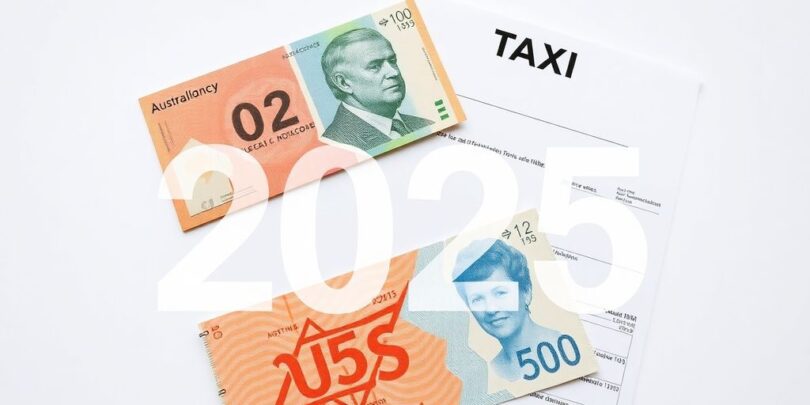G’day! So, the Australian income tax rules are getting a bit of a shake-up from July 2025. It’s not just about the big end of town either; these changes could affect how much cash you actually take home. Whether you’re working for someone else, running your own gig, or managing a small business, it’s a good idea to get a handle on what’s happening. We’ve broken down the key bits so you can figure out how these income tax changes 2025 might impact you and your finances.
Key Takeaways
- From July 2025, new tax brackets and rates will be introduced, aiming to reduce the tax burden for many Australians.
- Middle-income earners, particularly those earning between $45,000 and $135,000, are expected to see the most significant tax relief.
- Low-income earners will also benefit from a reduced entry-level tax rate.
- It’s wise to review your PAYG withholding arrangements and salary packaging strategies to ensure they align with the new tax structure.
- Small business owners should consider how these changes might affect their business structure, superannuation, and dividend strategies.
Understanding the 2025 Australian Income Tax Changes

Alright, let’s get into the nitty-gritty of what’s actually changing with Australian income tax from July 1, 2025. It’s not just a minor tweak; the government’s aiming to reshape how we’re taxed, especially for those in the middle-income brackets. The big picture is about reducing the tax burden for many working Australians and trying to keep pace with things like wage growth and the rising cost of living.
Key Updates to Tax Brackets and Rates
So, what does this mean for your wallet? The tax brackets are getting a bit of a makeover. The lowest tax rate is dropping, which is good news for people on lower incomes. But the most significant shift is the creation of a new, broader middle tax bracket. This is designed to catch a lot more people, and importantly, it comes with a lower rate than the previous brackets it replaces. For higher earners, the rates themselves aren’t changing at the very top, but the income levels at which those rates kick in are being pushed up.
Here’s a simplified look at the new structure:
| Income Range | New Tax Rate | Old Tax Rate (approx.) |
|---|---|---|
| $0 – $18,200 | 0% | 0% |
| $18,201 – $45,000 | 15% | 19% |
| $45,001 – $135,000 | 30% | 32.5% / 37% |
| $135,001 – $190,000 | 37% | 37% |
| $190,001+ | 45% | 45% |
This shift is intended to ease what’s known as ‘bracket creep’, where inflation can push your income into a higher tax bracket even if your actual purchasing power hasn’t increased.
Impact on Low and Middle-Income Earners
If you’re earning in the lower to middle-income ranges, you’re likely to see the most noticeable difference. The reduction in the lowest tax bracket means more of your initial earnings are kept. The real game-changer, though, is that new 30% bracket. It covers a much wider income span than the previous 32.5% and 37% rates did, and at a lower percentage. This means a significant number of people will be paying less tax on a larger portion of their income. It’s a direct attempt to put more money back into the pockets of everyday Australians who have been feeling the pinch.
The government’s aim here is to provide tangible relief, particularly to those who have been most affected by economic pressures. It’s about making the tax system feel fairer and more responsive to current economic conditions.
Changes Affecting Higher Income Thresholds
For those on higher incomes, the direct impact might feel less dramatic compared to the middle earners. The top marginal tax rates of 37% and 45% are still in place. However, the income thresholds at which these rates apply are being lifted. This means you’ll earn more before you hit those higher tax percentages. While the rate itself doesn’t change for the highest earners, the fact that you can earn more before that rate applies does offer some benefit. It’s less about a rate cut and more about a shift in the income levels that trigger those higher rates, effectively providing some relief by pushing the higher tax brackets further out. You can find more details on these changes at the ATO website.
Maximising Your Savings Under the New Tax Structure
So, the tax rates are changing from July 2025, and it’s a good time to think about how this might actually help your wallet. It’s not just about the government taking less; it’s about figuring out how to make the most of it for yourself. Understanding how the new structure affects your personal situation is key to maximising any savings.
Estimating Your Personal Tax Relief
Basically, the government is tweaking the tax brackets. This means that for a lot of people, the amount of tax they pay on their income will go down. The exact amount you save depends on how much you earn. For instance, if you’re earning somewhere in the middle range, you’ll likely see a more noticeable difference compared to those on the very lowest or highest incomes. It’s worth having a play around with some online calculators to get a rough idea of your personal benefit. Remember, these are estimates, and your actual situation might be a bit different depending on other factors like deductions you claim. You can check out the ATO website for tools to help with this.
Benefits for Dual-Income Households
If you and your partner are both earning, especially if you’re both in that middle-income bracket, the combined savings could be quite significant. When two incomes are taxed at lower rates, the overall household tax bill shrinks more noticeably. It’s a good idea to look at your combined financial picture to see the full impact. This might also be a good time to review how you manage your household finances and perhaps even look at how you structure any joint investments.
Understanding Proportional Benefits for High Earners
Now, if you’re earning a really high income, the changes might not feel as dramatic proportionally. While you’ll still benefit from the adjusted rates, the highest tax bracket still applies to income above a certain point. So, while your tax bill might decrease, the percentage of your income going to tax might not change as much as for someone in the middle. It’s more about the absolute dollar amount saved rather than a big shift in your overall tax percentage.
Planning ahead is always a smart move when tax laws change. Thinking about how these adjustments might influence your spending, saving, or investment decisions can help you make the most of the new system.
Here’s a simplified look at how the changes might affect different income levels:
| Income Range | Old Rate (approx.) | New Rate (approx.) | Potential Annual Saving (example) |
|---|---|---|---|
| $45,000 – $135,000 | Higher | 30% | More significant |
| $135,000 – $190,000 | Higher | 37% | Moderate |
| $190,001+ | 45% | 45% | Smaller proportional benefit |
Keep in mind these are general examples. Your actual savings will depend on your specific circumstances and any deductions or offsets you’re eligible for.
Preparing Your Finances for July 2025
With the new financial year kicking off in July 2025, it’s a good idea to get your finances in order. Think of it like tidying up before a big event – you want everything to run smoothly. Making a few adjustments now can really help you make the most of the upcoming tax changes.
Adjusting PAYG Withholding
If you’re an employee, your employer will likely update your Pay As You Go (PAYG) withholding amounts automatically to match the new tax rates. But if you’re self-employed or have income that varies a lot, it’s worth looking at your PAYG instalments. You don’t want to end up paying too much tax throughout the year, only to get it back as a refund later. It’s better to have that money in your pocket sooner rather than later. You can use the ATO’s website to get an idea of what your withholding should be.
Revisiting Salary Packaging Strategies
Salary packaging, like novated car leases or extra super contributions, can be a smart way to reduce your taxable income. With the tax brackets shifting, especially the new 30% rate applying to a wider range of incomes, it’s a good time to see if your current salary packaging arrangements are still as effective as they could be. What worked last year might need a tweak to stay optimal under the new system. It’s worth checking if adjusting your contributions could save you even more.
Planning Major Financial Decisions
Got a big purchase or investment planned? Maybe you’re thinking about buying property, starting a new business venture, or making a significant investment. Knowing your estimated after-tax income from July 2025 onwards can really help you time these decisions. For instance, if you’re looking at a large asset purchase, understanding your new tax position might influence when you sign the papers. It’s also a good time to consider things like the foreign resident capital gains withholding rate, which is changing from January 1, 2025, to 15% with no threshold [f8d6].
It’s not just about the big picture; sometimes the small, proactive steps make the biggest difference. Getting your financial house in order before the new rules start can prevent headaches down the line and ensure you’re not missing out on potential savings.
Navigating Changes for Small Business Owners

As a small business owner, the upcoming tax adjustments in 2025 mean it’s time to get strategic. It’s not just about your personal income; how your business is structured and how you manage its finances can make a big difference. Understanding these shifts is key to keeping more of your hard-earned money.
Impact on Wages and Business Structures
If you’re a sole trader or a company director who takes a wage, you’ll feel the direct impact of the new tax brackets, just like any other employee. But beyond that, it’s a good moment to think about your business structure. Is a sole trader setup still the best for you, or would a company or trust offer more advantages now? This could affect how you pay yourself and how profits are taxed. For instance, the way you distribute dividends might need a rethink to align with the new tax landscape.
Reviewing Superannuation and Dividend Strategies
With tax rates changing, it’s a smart move to look at your superannuation contributions. Are you maximising pre-tax contributions to lower your taxable income? Also, consider how you distribute profits. If you run a company, how and when you pay out dividends can have significant tax implications, especially with the new income thresholds. It’s worth discussing these with your accountant to make sure your strategy is still effective.
Opportunities in Retained Earnings
Think about your business’s retained earnings. How you manage these profits can also be influenced by the tax changes. Depending on your business structure and profit levels, there might be new opportunities or considerations for how you reinvest or hold onto profits within the business. Planning ahead can help you make the most of these situations. If you’re a small business owner who works from home, remember to check out the rules around claiming deductions for associated costs, as these can also be affected by broader tax changes. You can find helpful information on the ATO website.
It’s always a good idea to chat with your accountant or a tax professional. They can help you figure out exactly how these changes affect your specific business and personal situation, making sure you’re not missing out on any benefits or running into unexpected issues.
Leveraging ATO Resources and Professional Advice
It’s easy to get lost in all the changes coming up with the tax system in 2025. But honestly, the Australian Taxation Office (ATO) actually has a lot of stuff on their website that can help you figure things out. They’ve got these calculators that can give you a rough idea of what your tax bill might look like, which is pretty handy.
Utilising ATO Online Tools and Calculators
The ATO website is a goldmine for information. You can find tax calculators to estimate your liability, check your lodgement history, and even get guides on what you can claim. It’s all there to make things clearer. Don’t underestimate the power of these free resources. They can save you a lot of guesswork and potential mistakes. You can also use the ATO’s online services through myGov, which makes things pretty straightforward. It’s worth spending a bit of time on the ATO website to see what’s available.
Identifying Missed Tax Deductions
Lots of people miss out on deductions every year, which is basically leaving money on the table. Think about things like work-from-home expenses if you’re still doing that, or maybe costs for professional development related to your job. Even donations to registered charities can be claimed. It’s about looking at your spending throughout the year and seeing what relates back to earning your income.
The Role of Tax Offsets and Credits
Tax offsets and credits are different from deductions because they directly reduce the amount of tax you actually have to pay, rather than just reducing your taxable income. Things like the Low Income Tax Offset can make a real difference if you’re on a lower income. It’s important to know about these because they can significantly lower your tax bill, especially with the upcoming changes. Make sure you’re claiming everything you’re entitled to.
Key Dates and Compliance for the New Financial Year
Getting your head around tax deadlines is pretty important, especially with all the changes coming up. Missing a date can mean penalties, and nobody wants that. The Australian financial year runs from 1 July to 30 June each year. So, for the upcoming tax changes, we’re looking at the period starting 1 July 2025 and ending 30 June 2026.
Understanding the Australian Financial Year
The Australian financial year is the period from 1 July to 30 June. This is the timeframe the Australian Taxation Office (ATO) uses for tax assessments and lodgements. It’s good to keep this in mind when planning your finances, especially when dealing with things like superannuation contributions or business expenses. Knowing this cycle helps you stay organised throughout the year.
Tax Return Deadlines and Lodgement
For most individuals, the deadline to lodge your tax return is 31 October. If you use a registered tax agent, they often have an extended deadline, usually in May of the following year. It’s always best to check with your tax agent for their specific dates. For businesses, the deadlines can vary depending on your business structure and whether you lodge electronically or by paper. It’s wise to get your paperwork sorted well before the deadline to avoid any last-minute rushes. You can find a handy calendar of key dates for businesses on the ATO website, which is a great resource for staying compliant throughout the year.
Avoiding Penalties for Late Filing
Late lodgement penalties can really add up, so it’s best to avoid them. If you know you won’t meet a deadline, contact the ATO or your tax agent as soon as possible. They might be able to offer an extension, especially if you have a good reason. For those who owe tax, paying late also incurs interest charges. So, making sure you lodge on time and pay any tax due is key to keeping your financial affairs in order and avoiding unnecessary costs. It’s also worth noting that some changes, like the removal of deductions for general interest charges from 1 July 2025, mean it’s a good idea to settle outstanding amounts before the end of the financial year.
Wrapping Up: Your 2025 Tax Takeaway
So, there you have it. The 2025-26 income tax changes are coming, and they’re set to put a bit more cash back into the pockets of many Aussies. It’s not a massive shake-up, but the shift in tax brackets, especially for middle-income earners, is definitely something to pay attention to. Remember, these changes kick in from July 1, 2025, so you’ve got a bit of time to get your ducks in a row. Whether you’re an employee, a contractor, or running your own show, taking a moment to see how this affects you could make a real difference. Don’t leave it until the last minute; a little bit of planning now can help you make the most of it.
Frequently Asked Questions
What exactly are the 2025 Australian income tax changes?
From July 1, 2025, the government is changing the tax rates for most Aussies. Think of it like this: the amount of tax you pay on certain parts of your income will go down. This means more money stays in your pocket. For example, the tax rate for people earning between $18,201 and $45,000 will drop, and a new, lower rate will cover a bigger chunk of middle incomes.
Who gets the most help from these tax changes?
Most people will save money, but middle-income earners, those earning between $45,000 and $135,000, will likely see the biggest benefits. This is because a new tax rate applies to a larger portion of their income, and the old, higher rates are being reduced or moved to higher income levels. Low-income workers also get a boost with a lower entry-level tax rate.
Should I change how much tax my employer takes out of my pay?
It’s a good idea to check your Pay As You Go (PAYG) withholding. This is the tax your employer takes out of your pay each week or fortnight. If your tax rate is changing, your employer should adjust this automatically, but it’s smart to have a look at your payslip from July 2025 to make sure it’s correct. If you’re self-employed, you might need to adjust your own tax payments.
How do these changes affect small business owners?
Yes, especially if you’re a small business owner. The new tax rates affect the income you take as wages. It’s also a good time to look at how your business is set up, how you pay yourself, and how you manage your company’s profits. Thinking about things like superannuation contributions or how you distribute money to owners can also be important.
Where can I find more information or help?
The Australian Taxation Office (ATO) has heaps of helpful stuff online. They have tools to estimate your tax, guides on what you can claim as a deduction, and information about tax offsets. Using these resources can help you figure out your exact situation and make sure you’re not missing out on any savings.
When do I need to lodge my tax return?
The main deadline for lodging your tax return if you do it yourself is usually October 31. If you use a tax agent, they often get an extension, but you need to sign up with them before the October deadline. It’s really important to get your tax return in on time to avoid penalties and interest charges from the ATO.








